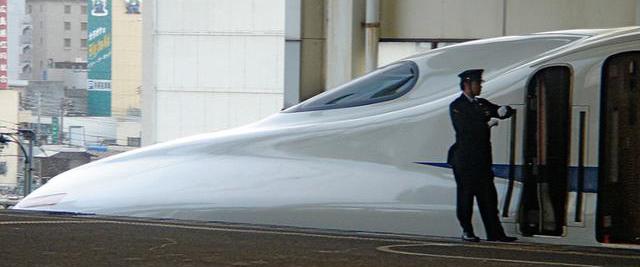Trends to Watch in 2015: High Speed Rail
"So long, expensive airfare. Hello, high-speed rail? The unveiling of a 300 mile per hour train in Japan renewed hope that we’ll have something similar here in America, and soon.
California is planning a high-speed bullet train, a $68 billion project that would run between Los Angeles and San Francisco in under 3 hours at speeds of over 200 miles per hour. In Texas, the private Texas Central High-Speed Railway is also looking to the Japanese bullet train to provide high-speed rail services between Dallas and Houston. The privately-funded system would use trains with speeds capable of 205 mph to make the connection in under 90 minutes. (For comparison, a flight from Dallas to Houston takes about 65 minutes).
The Japanese government, banking on the purchase of Japanese-made maglev trains, has committed to fund $5 billion of the estimated $10 billion needed to create an initial MAGLEV route segment between Washington, D.C. and Baltimore, which would manage that journey in just 15 minutes, the New York Times reports.
Competition has long been the best motivator for America, so lets hope Japan’s newest invention gets our gears turning."
From:
Urbanful
What's Happening Today, in the Cities of Tomorrow
Japan has a 300 MPH train. Is the U.S. next?
Japan recently unveiled a train that can reach speeds higher than 300 mph—in other words, it will one day cover 178 miles in 40 minutes. That’s sort of like going between Washington, D.C. and Trenton, New Jersey in less than an hour-long television drama.
There are efforts afoot in the U.S. to bring faster rail service to more corridors, but proponents face financial and political obstacles. The U.S. was already passed by when bullet trains took to the rails overseas. Now Maglev trains will likely do the same.
High Speed Rail vs. Maglev
Maglev (magnetically levitated) trains are not just faster versions of today’s high-speed rail technology: They are a different technology entirely.
High Speed rail operates with a connection between wheel and rail and is powered by electric-catenary, similar to traditional trains. Many high-speed rail systems that reach speeds between 186 and 225 mph operate on a dedicated high grade track, though high-speed rail trains, like Japan’s bullet train or France’s TGV, can operate on traditional tracks at lower speeds.
Maglev trains levitate in a concrete guideway thanks to magnets onboard the train that create a magnetic force with ground coils. The friction created by contact between the train wheels and the rail in high speed rail does not exist in maglev systems, enabling significantly faster speeds of 250 mph, and most recently in a new system in Japan, of 314 mph.
The Japanese Maglev
Though the concept of maglev was first developed in the 1960s in the United States, much of the progress and development of maglev train systems has happened overseas. Japan began working on a maglev train in the 1970s and started construction on a test line in 1990.
After years of testing, the Japanese government determined in 2009 that the newly developed SCMAGLEV (superconducting magnetically levitated train) was ready for commercial operation. In 2011 the Japanese government approved the Central Japan Railway Company (JR Central) to create a new route with SCMAGLEV technology, the Chuo Shinkansen, to connect Tokyo, Nagoya and Osaka, according to U.S.-Japan Maglev (USJMAGLEV).
In mid-November, Japan allowed riders to ride a section of the Chuo Shinkansen, which reached speeds above 300 mph. The proposed 178-mile route between Tokyo and Nagoya is expected to open to passenger service in 2027. The trip will take 40 minutes (compared to the current 90 minutes) thanks to speeds up to 311 mph . JR Central estimates the cost for the Tokyo to Nagoya route will be $52 billion; the entire route connecting Osaka to Tokyo could run $91.7 billion.
Fast Trains in the U.S.
America’s fastest train, comparatively, is pretty slow.
The Northeast Corridor’s Amtrak Acela Express can reach speeds of up to 150 mph, but averages speeds of 83 mph between Washington and New York and 66 mph between New York and Boston.
Amtrak’s $151 billion, Next-Gen High-Speed Rail Super Express plan would target key corridors for faster services, reaching speeds of up to 220 mph and cutting travel time between D.C. and New York from 2 hours, 42 minutes on Acela to 90 minutes. The faster speeds would rely on improvements in existing lines as well as new tracks and adjusted track configurations.
The project faces Congressional criticism for its cost. This fall, a U.S. House of Representatives committee passed The Passenger Rail Reform and Investment Act, which would cut funding for new construction by 40 percent, but the funding bill has not passed through the full House.
Elsewhere in the U.S., states are advancing their own efforts to bring high-speed rail service between major U.S. cities.
California is planning a high-speed bullet train with an estimated cost of $68 billion to run between Los Angeles and San Francisco in under 3 hours at speeds of over 200 miles per hour. The project is currently projected to deliver in 2030 with ridership estimates as high as 9.5 million riders annually, however the timeline, cost and ridership numbers all face strong criticism.
In Texas, the private Texas Central High-Speed Railway is also looking to the Japanese bullet train to provide high-speed rail services between Dallas and Houston. The privately-funded system would use trains with speeds capable of 205 mph to make the connection in under 90 minutes. (For comparison, a flight from Dallas to Houston takes about 65 minutes). Service could begin as early as 2021.
What was that about Maglev in the U.S.?
USJMAGLEV, a U.S.-owned and operated company committed to bringing SCMAGLEV to the U.S., wants to scrap plans for high speed rail in the Northeast corridor and instead bring maglev rail to the corridor.
With an estimated cost of $100 billion and speeds of up to 314 mph, a maglev train could transport passengers between New York and D.C. in 60 minutes.
The Japanese government, banking on the purchase of Japanese-made maglev trains, has committed to fund $5 billion of the estimated $10 billion needed to create an initial route segment between Washington, D.C. and Baltimore, which would manage that journey in just 15 minutes, the New York Times reports.
The Northeast Maglev advisory board has some significant clout from former leaders throughout the Northeast Corridor, to include Christie Todd Whitman of New Jersey, Ed Rendell of Pennsylvania and George Pataki of New York.
Wayne Rogers, chief executive of Northeast Maglev, told the New York TImes the maglev proposal is superior to the Amtrak proposal for high speed rail and questioned the merits of trying to improve train speed by using existing infrastructure.
“It’s like putting a Ferrari on the crowded Beltway around Washington: It’s not going to make it go any faster,” Rogers said.
Still, don’t expect levitating trains any time soon. The Northeast Maglev project would require significant government funding at both the state and federal level. Given current Congressional squeamishness about funding for the existing rail system, federal funding will be hard to come by any time soon.
Why We Can’t Have Fast Things
How is it Japan can support a $52 billion investment in a partial Maglev route with speeds above 300 mph and the U.S. can hardly get funding to support its existing trains that go no faster than 150 miles per hour?
For starters, Japan already has an extensive system of high speed rail throughout the country, making the addition of the even faster SCMAGLEV an easier sell.
Congress has struggled to pass funding to fix our existing roads and bridges—and most members of Congress LIKE cars. Funding a rail project that serves major cities in select, populated portions of the country, especially one that runs $100 billion, is a hard sell. And there is skepticism about the numbers: Many critics expect costs to run higher than estimates and question the projected ridership levels.
Future of U.S. High Speed Rail
The best chances for high speed rail (maglev or not) in the U.S. are in the project in California, which has at least some of its funding and electoral buy-in thanks to a ballot initiative. The Texas project is also a contender with its private dollars. Both of those projects are years away, more likely a decade or more. In short: If you really want to experience high speed rail, plan a trip overseas.
Related Articles
US High Speed Rail Association
National Association of Rail Passengers


